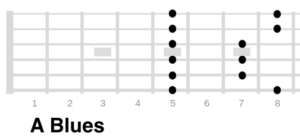Things You Need:
- Tuning ( 1. Tuning )
- Reading Guitar Tab ( 2. Guitar Tab )
- Open Chords (Recommended, not required for this section: 3. Open Chords)
- Bar Chords (Recommended, not required for this section: 4. Bar Chords)
- Pentatonic Scales (5. Blues and Country Scales)
You’ve done the hard work to learn pentatonic scales. The concepts behind playing the Country and Blues Scales all flow through to other scales. We’re going to tackle Major and Minor Scales first, because they relate most closely to the Country and Blues Scales.
Core Topics:
- Minor Scale: the Minor Scale is just the Blues Scale with 2 more notes. Here’s our A Blues Scale (1st form):

Here is the A Minor Scale with the additional notes circled:

I have circled 4 notes on this two octave scale. These 2 notes per octave are added to the Blues Scale to create the Minor Scale. Get your fingers used to adding these two notes, and learn the other forms, which are once again the same Blues Scale form with 2 notes per octave added. Go back to some of your favorite Blues Scale jams and see how these notes add more choices for you. You’ll find that these extra notes don’t always fit as well as the notes from the Blues Scale – there are many potential reasons for this. For now just have fun with the scales and get your ear used to the extra notes. You will decide as you get these things underneath your fingers whether, how, where, and when you want to use the extra notes. - Major Scale: just as the Minor Scale adds 2 notes per octave to the Blues Scale patterns, the Major Scale simply adds 2 notes per octave to the Country Scale.
Here is the A Country Scale (1st form):

Here is the A Major Scale with the additional notes circled:

Same exercise as with the Minor Scale: get the new notes under you fingertips for each form by playing along to things you like to play the Country Scale to. Decide whether and how you like to use the extra notes.
Deeper:
-
- Relative Major / Minors: This is a concept you’ve run into before with pentatonic scales and related blues/country scales. We’ll see it again when we go to Modes. There are many perspectives you can take with this, from memorizing the relationship pattern to diving deep into the theory. If you like to solo and improvise, search out content that makes the best sense to you on this topic and learn it deeply – it will take you far. Heres one of my favorite videos on this topic:
- Relative Major / Minors: This is a concept you’ve run into before with pentatonic scales and related blues/country scales. We’ll see it again when we go to Modes. There are many perspectives you can take with this, from memorizing the relationship pattern to diving deep into the theory. If you like to solo and improvise, search out content that makes the best sense to you on this topic and learn it deeply – it will take you far. Heres one of my favorite videos on this topic:
- Phrasing: We have more notes to choose from, which means more options to alter phrasing. Learn where the new notes are, how they relate to the others, how you can bend with and to them and incorporate them into your phrasing.
- Passing Tones: these are notes, often pulled from the chromatic scale, that produce motion towards other notes. Do some online searches for passing tones and you will find discussions on them from genres from punk to jazz and everything in between.
- Dissonance: this is a concept not necessarily related directly to major and minor scales, but it is something that should hit your radar once you have come this far in your understanding of guitar. Dissonance is used by people is many ways, do some searches and think about introducing it to your playing. For people who do not like the sound of dissonance, you may find that you like the sounds of dissonance resolving back to “normal” notes.
More links for Major/Minor Scales:

